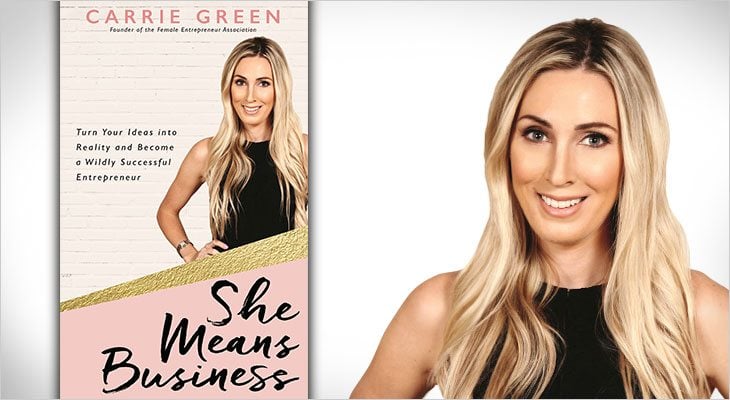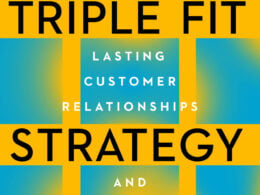The key to building a wildly successful business is going above and beyond to serve your audience. You have to be able to communicate what you have to offer so well that they want to become a fan, follower, subscriber and customer. In order to do this, you have to know who they are, so here’s a snippet from my book, “She Means Business,” to help you get clearer picture on who exactly your audience are.
The following excerpt is provided exclusively for StartupNation from “She Means Business” by Carrie Green, Hay House UK, £10.99, released Feb. 21, 2017.
“She Means Business” is available now at fine booksellers, and at StartupNation.com.
Who are your audience?
Once you’re clear about what your business mission is and what’s at the heart and soul of it, the next thing you need to get really clear about is who your audience are, who you want to serve, who you’re trying to get your message and business in front of.
One of the reasons why The Honest Company is so successful is because they’re so clear about who their audience are and they do everything with their target audience in mind. Their products are definitely not for everyone and they don’t try to be.
Their target audience is someone who believes in using non-toxic products in their home. They are proud of their home and want things to look good – I’m sure there’s more to their audience than this, but the point is that they’ve created their products for that person.
I was compelled to buy one of their products because it resonated with me on every level, because I am their target audience and I have the same beliefs and ideals as them.
I believe that the products I use should be non-toxic and eco-friendly, and so do they.
I strive to make my home feel good and look beautiful. Their products strive to do the same thing. They look stylish, not like ‘normal’ cleaning products.
These things make me feel like me and this brand belong together.
You want your audience to feel like they belong with you and your business. In order to achieve that, you need to know exactly who they are.
When I was starting FEA, I knew my audience were women who were thinking about starting a business or already running a business. But that was about all I knew and there was a massive part of me that thought, “Maybe I should just create something to inspire everyone! I’d love to help children and teenagers to feel inspired and empowered, and I’d love to help people realize their dreams!” I felt passionate about helping lots of different people and I think this is something a lot of us feel – we want to help and appeal to everyone.
However, this is a recipe for disaster, because the way you communicate with a child is totally different to the way you’d communicate with an adult. And you’d probably communicate differently with a woman than you would with a man. So, if we try to please everyone, we’re actually not really resonating much with anyone.
So, while it’s good to have dreams about helping everyone, start off by getting laser focused on one particular audience.
My decision to focus on female entrepreneurs crystalized because everything I seemed to be creating felt completely geared to women. I was using pinks, and I was writing like I was talking with my girlfriends. Sometimes you have to get started taking action to realize what feels like the right thing to do. And just because you’re narrowing your focus now, doesn’t mean you can’t widen it later on, so don’t worry about that.
When I started to think more about who my audience was, I realized I didn’t know her challenges, her dreams, desires, or fears. So, initially, I took some time to think about who she might be. Since I had no one to ask, because I hadn’t actually put FEA out there, I set aside some time to write about her and get to know her. I started by thinking about the following things in relation to her star ting and building a business:
- What are her desires? What does she want to achieve?
- What’s holding her back?
- What are her challenges – internal (i.e. specific doubts and worries she has, like not feeling good enough, not believing she can make it happen) and external (i.e. things going on around her that might be holding her back, maybe she doesn’t think she has enough time, or maybe she has a challenge with money, etc.)?
- What are her fears?
- What does she need help with in order to achieve her vision?
I knew that a woman in my audience would have a burning desire to turn her ideas into reality and build a successful business. I knew that she’d probably be feeling quite alone on her journey and would be looking for like-minded people for help and support. I knew that if she were searching on Google for help with building her business, it meant that she wanted someone to show her how to breakthrough, how to up-level, how to actually do it.
I knew all this because that was my personal experience. I knew my own dreams, desires, challenges, and fears, so that was my starting point.
There are so many questions you can ask yourself as you’re digging into who your dream audience are.
My friend Nikki asked herself, “Who would pay me for help with communication?”
That was enough for Nikki to get going, and throughout her journey she’s got to know her audience more deeply, as she continues her mission to help entrepreneurs attract their dream clients one brilliant message at a time.
Related: Former Google Career Coach on Career Conversations [Book Excerpt]
My sister, Sam, ended up realizing the importance of this question once she’d got her business up and running. She started her graphic design business thinking her audience was female entrepreneurs, only to realize a year later that the entrepreneurs she seemed to be attracting had no money to pay her.
So she decided to go back to the drawing board and rethink who she wanted her audience to be. Since starting her business, she’d got married and designed her own wedding stationery, which sparked the idea of using her graphic design skills to design wedding invites – something that brides were definitely prepared to pay for.
You don’t have to have it all perfectly figured out, and sometimes people get started thinking their audience is one person, only to discover later on that it’s someone else.This is exactly what happened to Michelle Rohr.
In the early days of running her blog, Michelle thought her audience was college dropouts. People, like her, who went to college and decided it wasn’t for them, quit, but then had no clue what to do next. So everything she was creating was aimed at those people. Then after a year or so, Michelle decided to survey her audience and find out more about who was reading her blog. She was shocked when she discovered it wasn’t college dropouts, it was women in their 30s and 40s, who had a desire to take 100 percent responsibility for their lives. Once she found this out, she adjusted the content she was delivering, so it would resonate more with her actual audience.
Remember, you can adjust as you build. It’s all an evolution.
It’s all a journey, with twists and turns, so do what you can now with what you know, to get as clear as possible about who your audience are and dig deeper as you go.
The main reason why you want to understand your audience as much as possible is because throughout your entrepreneurial journey you’ll need to take your lead from them.
So many entrepreneurs get this part wrong, they think their business is all about them – their dreams, their desires, their goals – but if you want to make your business a success then you have to shift your focus from yourself to your audience.
Your business is not about you; it’s about them – your wonderful audience. It’s about their needs, their desires, their problems and challenges, and it’s up to you to understand them as much as possible.
The more connected you are with your audience, the more you’ll be able to resonate with them.
Once you begin to build your audience, through social media, email subscribers, customers etc., you can begin to survey them to find out more about their dreams, desires, challenges and fears. I love asking my fans, followers and subscribers, “What’s your number one frustration as an entrepreneur right now? Where are you at in your business journey? What would you love help with right now?”
I constantly ask my audience questions, via my Facebook page and through surveys, so that I can understand where they’re at in more detail.
The answers I receive are like gold dust, because they tell me in their exact words what I can do to help them more. In the past, I’ve used the words that people have written in survey responses in my website copy and posts, because it communicates exactly how so many of the women in my audience actually feel, and then I get messages back from them saying, “It’s like you read my mind.”
Keep this simple and just do all you can throughout your journey to get to know your audience the best you can.
Related: Sign up to receive the StartupNation newsletter!
“She Means Business” is available now at fine booksellers, and at StartupNation.com.






